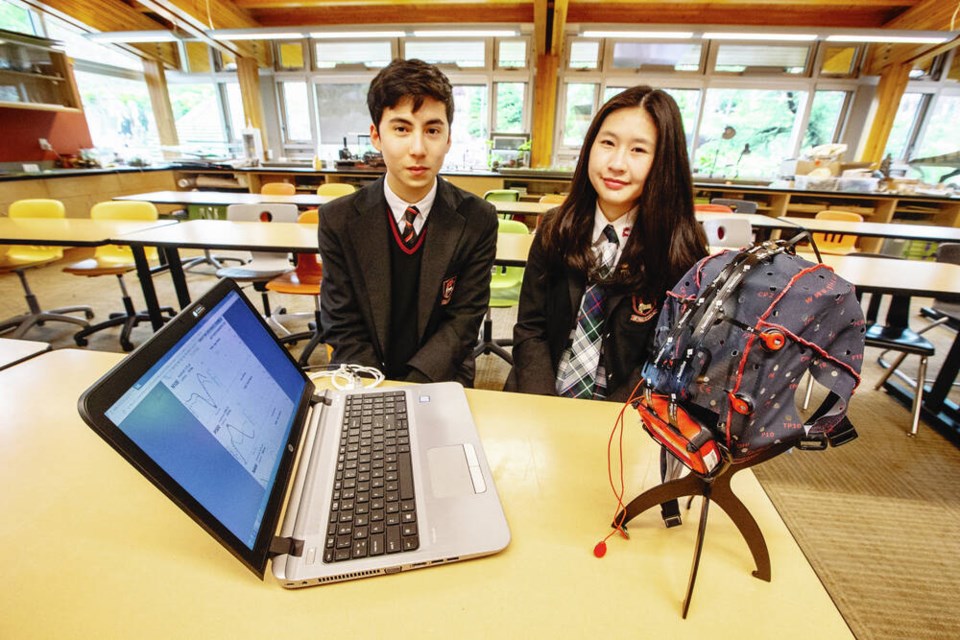It’s called the BRAIN team — for Brentwood Research Applied Innovation in Neuroscience — and it’s made up of high schoolers intent on charting the effect of various sports on concussions and other brain issues.
The handful of Brentwood College School students has been compiling data from a range of their peers’ athletic activities throughout the school year, and are looking to dive into the analysis stage this summer.
Julian Wan, a Grade 12 student, said she sees the research effort as a benefit to her plan to become a doctor. Another participant is a former Brentwood student who is staying involved while studying neuroscience — the structure and function of the brain and nervous system — at University College London in England.
“This study has really helped me to gain more experience in the scientific and the clinical aspect of medicine,” Wan said.
She said what she and her friends are doing can make people be more aware of what can happen to their brains.
“We’re just hoping people know that their brain is very sensitive, and little head contacts might result in a cumulative affect of several impacts.”
That awareness could help people take better care of their brain health in later life, Wan said.
At the centre of it all is a brain-monitoring device called the NeuroCatch Platform developed by Brentwood alumnus Ryan D’Arcy, who graduated from the Mill Bay school in 1990. The staff leader of the study is David McCarthy, who was D’Arcy’s biology teacher back then and told him he had a “knack” for science.
D’Arcy said his first memory of being interested in neuroscience was dissecting a dogfish in McCarthy’s class and wanting to see what the brain looked like. The two reconnected when D’Arcy gave a TEDx talk at Brentwood a few years ago.
“I’ve always been interested in supporting younger, up-and-coming scientists,” D’Arcy said.
McCarthy is retiring after this school year and is happy to be involved with a project linked to a former student.
“This is kind of a last kick at the can, although I may just continue in a volunteer capacity with this particular project if kids are interested in continuing.”
He said Brentwood has a three-term sports system that has allowed for comparison between contact and non-contact activity. There have been sports like soccer, field hockey and ice hockey, with rowers, climbers and tennis players among the control groups.
“We’re not expecting to see a concussion in many kids, but below concussion-level effects is really what we’re looking out for when we get to the analysis stage of the results.”
About 20 students in non-contact sports and more than 60 students in contact sports will likely be involved.
McCarthy said he is looking for a positive component to the study.
“As a former rugby player, I’m actually hoping to see no difference between the rugby players and the other sports,” he said. “The last thing I would want to do would be to put kids off going into a sport like rugby.
“What I’m hoping is it can contribute to this device becoming one that can be used by medical staff and physios to track the recovery from concussion and to maybe say when [players] have got a clean bill of health.”
He has another idea for NeuroCatch’s use.
“I think there’s a possibility it’s biggest use could be in monitoring cognitive changes in older people, so people who might be on the decline mentally could get some kind of real evaluation as opposed to just filling in a form.
The NeuroCatch, based on over 25 years of research, is a cap with sensors that fits snugly on the head and measures brain waves using electroencephalography, or EEG. The first version was launched in 2019 as a Health Canada-approved medical device.
“It’s completely non-invasive,” D’Arcy said.
Watching how a brain functions usually involves very sophisticated, very expensive, “Star Trek-like” technology, he said, but NeuroCatch, being portable, makes the process far more accessible.
“It’s not embedded within an advanced hospital laboratory.”
A larger machine like an MRI can cost in the millions, while NeuroCatch is currently $35,000.
Attention to concussions in contact sports such as football and hockey and the 2015 Hollywood film release of Concussion have made brain injury a common topic in recent years.
But D’Arcy stressed that NeuroCatch is not a concussion scanner.
“It’s kind of interesting because certainly concussion is one of the major problems we address, but the way we went about was we actually asked the bold question: ‘Why don’t we have a vital sign for our brains?’ ”
NeuroCatch takes that approach, measuring things like cognitive brain function — including thinking and reasoning — along with injuries, diseases and mental health.
The Vancouver-based D’Arcy has taken NeuroCatch further afield and has been collaborating with studies at places like the Mayo Clinic on concussions in hockey and the Sanford Clinic on concussions in youth football.
“The NeuroCatch is deployed throughout North America,” he said, adding that it has also been used to scan SpaceX passengers.
The Brentwood situation also allowed for regular testing to see how long it takes for the effects of a knock to the head to go away. D’Arcy said the students have done great work.
“They’ve really demonstrated there’s this untapped scientific potential in our high school students. They’re not along for the ride, they’re driving the bus.”



